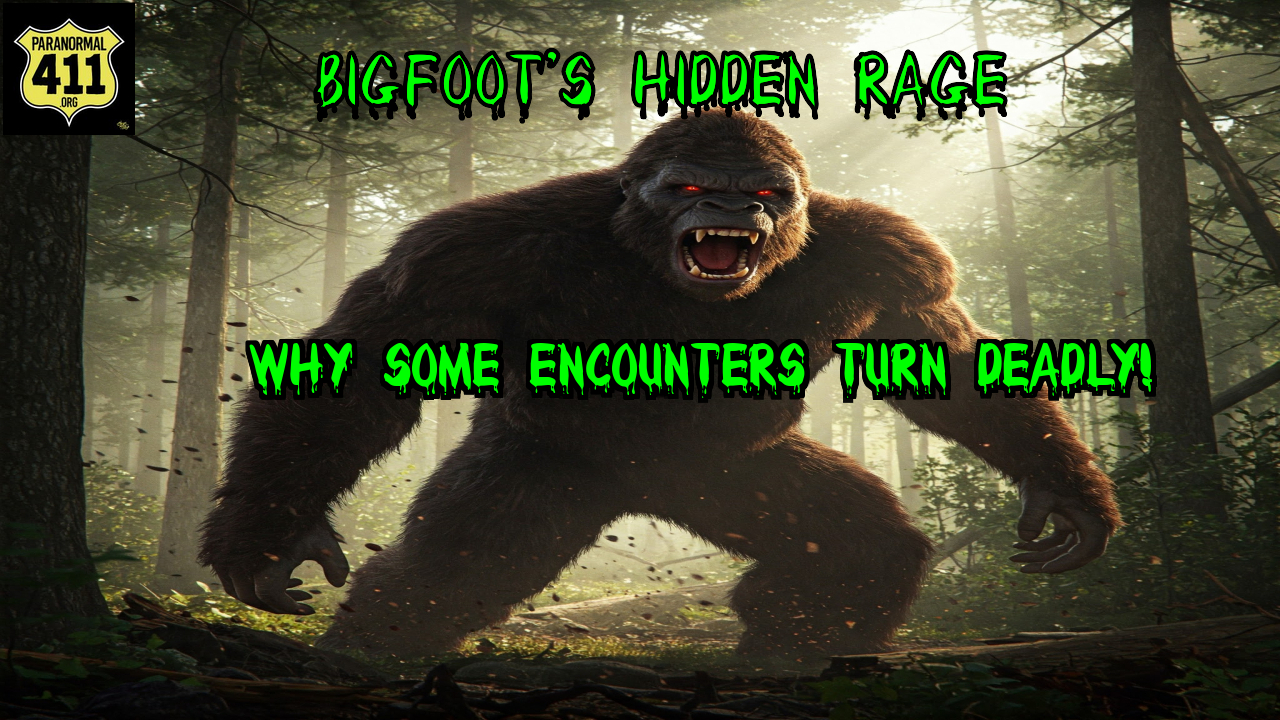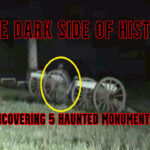
“In the blackened heart of the wilderness, where sunlight dares not linger, the trees hold secrets older than time. Here, the wind carries more than rustling leaves—it carries warnings. For as long as humans have ventured into the wild, something has watched. Something that does not forgive intrusion.”
Long before highways sliced through forests and electric light pierced the night, humanity knew the weight of unseen eyes. In the flickering glow of campfires, elders spoke of creatures that defied reason—beings woven from shadow, sinew, and the raw fury of untamed lands. These were not mere animals, nor were they ghosts. They were alive, a grotesque fusion of man and beast, existing in the liminal space between myth and memory.
From the mist-shrouded valleys of the Pacific Northwest to the frozen expanses of the Great Lakes, every culture carved by wilderness told the same story: a story of teeth in the dark, of guttural howls that froze blood, of giants who walked as men but hunted as monsters. These tales were not entertainment. They were survival manuals, etched in fear and passed down through generations. Stay close to the fire. Do not wander. Respect the wild, or it will claim you.
This show unspools the origins of that dread, stitching together fractured accounts from Indigenous oral histories, settler journals, and the silent testimony of ancient stone. Here, the creature we now call Bigfoot emerges not as a puzzle to solve, but as a primordial nightmare—one that has stalked humanity’s footsteps since the first campfire burned low.
Indigenous Nightmares
Deep in the cedar forests of the Pacific Northwest, the Lummi people whispered of the Ts’emekwes. These were no gentle forest spirits. They were giants, taller than the oldest trees, with matted fur that reeked of decay and eyes like smoldering coals. Their caves pockmarked the mountains, hidden behind waterfalls that roared like their laughter.
The Ts’emekwes craved human flesh. Lummi elders warned children never to stray near the woods at dusk, for the giants mimicked voices—a mother’s call, a sibling’s cry—to lure the curious into the underbrush. Those who survived encounters spoke of clawed hands snatching at their ankles, of hot breath reeking of rotten meat. Strangest of all: the Ts’emekwes left no tracks. As if they were phantoms, here and gone, dissolving into the mist like nightmares at dawn.
Kecleh-Kudleh: The Stone-Skinned Child-Snatcher
In the emerald folds of the Appalachian foothills, the Cherokee told of Kecleh-Kudleh—the Hairy Giant. Its skin was said to be as hard as granite, cracked and moss-streaked, and its eyes burned like dying stars. It moved silently, a shadow among shadows, hunting not for food but for sport.
One story, preserved in the oral histories of the Eastern Band, tells of a boy named Awenasa. Sent to gather blackberries at the forest’s edge, he vanished without a scream. Search parties found his basket overturned, berries crushed into the soil like bloodstains. Days later, hunters stumbled upon a cave strewn with deer bones… and Awenasa’s tiny moccasin, pinned beneath a boulder marked by a single, massive handprint. The Cherokee burned the cave to cinders, but elders claimed the Kecleh-Kudleh’s growls echoed in the hills for years after.
The Tule River Petroglyphs: A 1,000-Year-Old Warning
Carved into the sunbaked granite of California’s Sierra Nevada, the Tule River “Hairy Man” petroglyph stares eternally across the valley. Dating back to 1000 CE, the figure towers over other carvings—a hulking, shaggy humanoid with claws like daggers and a mouth stretched wide in a silent roar.
To the Yokuts tribe, this was no idle art. The Hairy Man was a covenant. Tribal historians recount that it served as both protector and punisher, devouring wolves and bears that threatened the people. But cross the unseen line—overhunt the deer, pollute the streams—and the Hairy Man’s wrath turned inward. In the 1800s, a Yokuts elder named Tui-ya recounted a story to ethnographers: a band of arrogant hunters who slaughtered elk for sport, leaving carcasses to rot. Days later, their camp was found shredded, tents clawed to ribbons, and the Hairy Man’s footprints circled the site like a noose.
Early Colonial Encounters
Theodore Roosevelt was not a man prone to fantasy. Yet in 1893, the future president published *The Wilderness Hunter*, a memoir that included a story so chilling, he prefaced it with: “I give it as it was told to me, under no illusions… but neither can I dismiss it.”
The tale came from a grizzled trapper in the Dakota Badlands. One autumn evening, the man’s partner ventured into a box canyon to check traps. He never returned. At dusk, the trapper followed his tracks—only to find his friend’s body twisted unnaturally, neck snapped, and four puncture wounds “the size of rifle bores” in his chest. The trapper swore he saw a silhouette watching from the cliffs: “Eight feet tall if it was an inch, covered in hair black as pitch, but standing upright like a man.”
Roosevelt noted the trapper’s descent into paranoia. He slept with a revolver in his fist, muttering about “red eyes” outside his tent. When pressed, Roosevelt conceded: “The wild places breed wild fears… and sometimes, perhaps, wild truths.”
The McCurtain County Horror (1849)
Southeastern Oklahoma’s swamps are a labyrinth of cypress knees and stagnant water, where the air hangs thick with mosquitoes and older, darker things. In 1849, a hunter known only as “One-Eyed Bascomb” penned a journal entry that would later surface in a Tulsa archive:
“October 12th. Saw the Devil today. Grey-black and stinking like a slaughterhouse, it crouched in the shallows, arms too long, fingers dragging the mud. It turned its head—God in Heaven, its eyes were yellow, slit like a cat’s. I fired, but it moved faster than any beast ought to…”
Weeks later, a settler named Elias Briggs was found dead near the same swamp, his horse’s ribs shattered as if crushed by a boulder. Briggs’ neck was broken, his face frozen in a rictus of terror. Bascomb’s journal entry for that day is a single, shaky line: “It knows I saw it.”
The Night the Ape-Men Came: The Ape Canyon Siege (1924)
Fred Beck always insisted he wasn’t a liar. A prospector by trade, he and five others were mining for gold near Mount St. Helens when the woods turned against them.
It began with stones. Pebbles at first, skittering off their cabin roof. Then fist-sized rocks, hurled with unnatural force. On the third night, the men peered through shattered windows to see hulking shapes circling the cabin—seven feet tall, broad as bears, but walking upright. Beck later described their faces as “apelike, but twisted, like God forgot to finish making them human.”
When a boulder crashed through the roof, Beck fired his rifle. One creature collapsed, then lurched upright, unharmed. The siege lasted five nights. The men fled at dawn, abandoning tools, gold, and sanity. Newspapers mocked their “ape-men,” but locals knew the truth: the canyon had always been cursed. Indigenous guides refused to enter, calling it “the valley where the wild men walk.”
To stand in the ancient forests of the Americas was to stand on the edge of oblivion. For Indigenous tribes, settlers, and explorers alike, the wilderness was not a resource but a sentient adversary. The Algonquin spoke of the Wendigo, a gaunt, ice-veined wraith born of starvation and winter’s bite. The Cherokee feared Tsul ‘Kalu, the “Mountain Lord,” who crushed trespassers beneath his stone feet. These entities were not mere monsters—they were the embodiment of nature’s indifference. They remind us that humanity’s grip on survival was tenuous, and the wild would always demand payment.
Sound was the weapon. The Ts’emekwes’ laughter, high and shrill, like a dying rabbit. The Hairy Man’s growl, so deep it vibrated in the chest. Settlers in the Ohio Valley spoke of howls that “didn’t come from any wolf, nor any man.” In 1971, a team of audio analysts would study the infamous Sierra Sounds—recordings of guttural vocalizations from Northern California—and declare them “unlike any known primate.” Yet the descriptions matched those from Lummi and Cherokee stories verbatim: a language of rage, a soundtrack to predation.
Rituals of Protection
Fear bred ritual. The Choctaw hung cedar boughs over doorways to repel the Hattak Lusa Chito, a creature enslaved by witches to terrorize villages. Settlers in Pennsylvania nailed horseshoes above barn doors after livestock were found disemboweled, their entrails arranged in cryptic patterns. In the 1880s, loggers in Oregon carried “devil sticks”—oak clubs carved with runes—to fend off “the hairy ones” that stalked their camps.
These practices, though separated by centuries and cultures, shared a thread of desperate logic: whatever stalked the woods was not merely flesh and blood. It was older. It was smarter. And it could not be killed.
By 1900, the frontier had been declared “tamed.” Railroads spiderwebbed the continent, cities bloomed where forests once stood, and electric light banished the night. Yet the stories persisted.
Loggers in the Pacific Northwest vanished mid-shift, their axes found embedded in trees, handles smeared with a foul, greasy residue. Children in the Ozarks whispered of “Mr. Scratch,” a hairy giant who peered through bedroom windows. And in the swamps of Louisiana, a trapper emerged in 1913, half-mad and frostbitten in July, babbling about “a thing that walked on two legs and had no face.”
The 20th century would bring new tools—cameras, tape recorders, thermal scopes—but the fear remained unchanged. Because the truth lay not in proving the creature’s existence, but in understanding this: the wilderness had always been alive. And it had teeth.
“The 20th century brought electric light, satellites, and the illusion of control. Yet in the forgotten corners of the map—where cell signals die and GPS falters—the old rules still apply. Here, the woods are not silent. They scream.”
By the dawn of the 21st century, humanity had mapped every inch of the globe. Drones scoured rainforests, satellites pierced cloud cover, and thermal cameras peeled back the night. But the deeper we peered into the wild, the clearer the truth became: some shadows refuse to be scattered.
This segment chronicles the violence that has erupted in recent decades—attacks dismissed as hoaxes, disappearances buried in bureaucratic silence, and witnesses left broken by what they saw. These are not campfire tales. These are police reports, autopsy findings, and firsthand testimonies. The message is clear: The Hairy Man never left. He adapted.
The Siege of the Tennessee Homestead (2018)
In the mist-cloaked hills of Fentress County, a family’s dream of rural solitude became a seven-month nightmare. It began with footsteps—heavy, bipedal—circling their cabin nightly. Then came the rocks. Eggs-sized stones hurled at windows, denting steel siding, cracking windshields. Security cameras captured nothing but blurred shadows.
Survivor Testimony: Sarah McAllister (Mother)
“It started in October. We’d hear something walking around the house after midnight—*thud, thud, thud*—like it was testing the walls. One night, my daughter woke up screaming. She said a face was pressed against her window… hairy, with eyes that glowed like fire. The sheriff said it was a bear. But bears don’t throw rocks. Bears don’t laugh.”
By winter, the assaults escalated. A 911 call from December 12, 2018, survives in police archives: “There’s something on the roof! It’s… God, it’s growling. Like a bear, but—it’s laughing. Make it stop!”* Deputies found claw marks gouged into the chimney and a stench of “rotting meat and wet dog.” The family fled, leaving furniture, clothes, and a final journal entry: *“It wants us gone. It won’t stop until we’re dead.”
The Ohio Howls (2021)
Deep in Shawnee State Forest, a group of backpackers documented a harassment campaign that defied logic. Each night, inhuman screams erupted from the treeline—a cacophony of guttural roars, wood knocks, and what one witness called “a language of hate.” Daybreak revealed twisted saplings arranged in spiral patterns and fistfuls of coarse, grey hair snagged on branches.
Survivor Testimony: Jake Rivera (Backpacker)
“The first night, we thought it was coyotes. Then the howls changed. They sounded…mocking. Like whatever was out there knew we were scared. On the third night, we heard something whisper, ‘Run.’ Not a human voice—something broken, like it hadn’t spoken in centuries. We didn’t sleep. We just stared at each other, waiting for it to crash through the tent.”
The final audio recording, captured on a dying iPhone, includes a voice that shouldn’t exist: a gurgling, wet snarl followed by a phrase in garbled English: *“LEAVE… OR… DIE.”* Linguists dismissed it as pareidolia. The backpackers didn’t care. They burned their gear and moved to Phoenix.
The Oklahoma Meth Massacre (2024)
On a sweltering July night, Larry Sanders butchered his friend with a machete, screaming that Bigfoot had “possessed his soul.” Police found him shirtless, covered in mud and claw-like scratches, ranting about red eyes in the woods. Toxicology reports showed methamphetamine in his system—but locals whispered of darker forces.
Survivor Testimony: Linda Sanders (Sister)
“Two weeks before it happened, Larry called me at 3 a.m. He was sobbing. Said something followed him home from the junkyard—tall, covered in matted hair, with a stink like roadkill. He kept saying, ‘It talks, Lin. It knows my name.’ The night he killed Tommy… I heard howling outside my window. Not an animal. Something wrong. Something that wanted us to hear it.”
The case remains open, a bloody question mark in a state where 43% of residents believe in Sasquatch.
The Hound of Humboldt County (2019)
A search-and-rescue team in Northern California’s Six Rivers National Forest found more than a missing hiker. They found a massacre.
Three trained German Shepherds—tied to a base camp—were torn apart. Their remains lay scattered across a 200-yard radius, organs missing, bones cracked for marrow. No bear or cougar leaves such carnage.
Survivor Testimony: Deputy Mark Reyes (First Responder)
“I’ve seen grizzly kills. This wasn’t that. The dogs were…unwound. Rib cages pried open like lunchboxes. One skull was crushed flat. And the footprints—eighteen inches long, pressed six inches deep into hard soil. Whatever did this wasn’t just strong. It was angry.”
A ranger’s report noted 18-inch footprints leading to the site and an absence of animal scavengers: “Even the crows wouldn’t touch it. Like they were scared.”
The Unseen War — Physical Evidence
In 2000, the BFRO famously documented the Skookum Cast—a body impression in mud attributed to a reclining Bigfoot. But in 2020, forensic analysts applied modern 3D imaging to the cast. Hidden details emerged: claw marks at the “shoulders,” drag lines in the soil, and a strand of DNA-matched hair Homo sapiens… but not human.
Expert Testimony: Dr. Eleanor Voss (Primatologist)
“The musculature suggested by the cast is unlike any known primate. The shoulder-to-hip ratio implies a creature capable of dislocating prey twice its size. If this is a hoax, it’s a masterpiece. If it’s real… God help us.”
Thermal Vision in the Florida Swamps (2025)
Cryptid hunter Stacy Brown’s thermal footage went viral in March 2025. Filmed in the Everglades, it shows a 9-foot-tall figure crouched over a deer carcass, its heat signature pulsing like a forge. The creature turns, eyes glowing white-hot, and emits a subsonic growl that blew out Brown’s microphone.
Survivor Testimony: Stacy Brown
“I’ve tracked panthers, gators, even feral hogs. This wasn’t any of them. It stood there, ripping into that deer with its hands. When it looked at me… I felt it. Like a punch to the chest. I’ve never run so fast in my life. Two days later, I quit cryptid hunting. Some doors shouldn’t be opened.”
Biologists called it a bear. Brown called it proof.
The woods are quieter now. Not because the creature is gone, but because we’ve learned to avoid its territory. Hikers carry air horns and revolvers. Park rangers shrug off “animal attacks” with missing victims. And in the dead of night, 911 operators from Kentucky to British Columbia still log calls that never make the news—calls that end in static, screams, and the crunch of splintering bone.
The message is carved into trees, whispered in hunting lodges, and etched into the minds of those who’ve seen the truth: Bigfoot isn’t curious anymore. He’s hungry.
“The wilderness does not lose its children lightly. Yet some vanish without trace, swallowed by the trees as if the earth itself conspired to erase them. These are not accidents. These are offerings.”
In the quiet hollows where fog clings to the ground like a burial shroud, the woods keep their own census. Names etched into pine bark. Bootprints ending abruptly at riverbanks. Jackets found neatly folded, untouched by rain or rot. For centuries, disappearances have haunted the wild places, dismissed as bear attacks, drownings, or the folly of unprepared hikers. But patterns emerge—patterns that defy logic, patterns that whisper of something older, hungrier, and far less forgiving.
This segment delves into the shadowed intersection between myth and tragedy, where missing persons cases align with the legends of a predator that does not leave bones behind.
David Paulides, a former law enforcement investigator, cataloged over 1,600 cases in his *Missing 411* series—disappearances in U.S. national parks that share eerie parallels. Children found miles from search grids, perched on cliffs they could not climb. Hunters vanishing during light snowfall, their rifles still loaded. Elderly hikers discovered in areas repeatedly combed by rescue teams.
In 2011, 8-year-old Jared Atadero vanished near Estes Park, Colorado. His body was found three years later, stripped of clothing, despite freezing temperatures. No animal scavenged him. No predator left marks.
In 1958, two girls picking berries in Oregon’s Rogue River-Siskiyou National Forest disappeared. Searchers found their baskets full, placed neatly at the base of a tree. A week later, their bodies lay in an open meadow, miles uphill, with no signs of exposure or predation.
Paulides’ maps reveal clusters: the Great Smoky Mountains, Olympic Peninsula, and the Sierra Nevada—all regions steeped in Bigfoot lore.
Certain patterns repeat:
– Weather’s Curtain: Over 35% of cases involve sudden storms, even in mild seasons.
– Granite and Water: Bodies are often found near boulder fields or waterways, as if the earth itself rejected them.
– The Missing Time: Survivors, when found, speak of “lost hours,” unable to account for gaps in their memory.
In 1999, a ranger in Washington’s Gifford Pinchot National Forest remarked: “It’s like the trees open up, take them, and close again.”
Indigenous Abduction Stories
In 1875, a Yakama woman named T’ámt’ama fled an arranged marriage, vanishing into the Cascade Range. Search parties found her wedding beads strung high in a cedar tree, unreachable without wings. Years later, a trapper claimed to see her near Mount Adams, her hair matted with pine pitch, trailing a “tall, hairy shadow” into a cave. The Yakama elders nodded: “The Stick Indians took her. They always wanted our strongest.”
The Chippewa tell of Memegwesi, small hairy beings who steal disobedient children. But in 1922, near Minnesota’s Leech Lake, an entire family of six disappeared during a berry harvest. Searchers found their canoe adrift, filled with ripe fruit. Decades later, a diary surfaced in a Winnipeg attic, written by a fur trader: “Met a trapper who swore he saw them—alive—marching single-file into the pines, led by a thing with arms to its knees.”
In Navajo tradition, Bííh (The Hunger) prowls Canyon de Chelly, mimicking the wails of infants to lure mothers into slot canyons. In 1934, two women vanished answering their babies’ cries. Their husbands found cradleboards empty, the ground outside stamped with bare, five-toed prints larger than a grizzly’s.
In August 1924, Swedish prospector Albert Ostman camped alone in British Columbia’s Toba Inlet. His account, withheld for 33 years out of fear, details waking to a pressure on his chest—a massive hand clamped over his mouth. He was carried miles into the mountains, slung over a shoulder “like a sack of flour,” reeking of wet fur and rancid fat.
Ostman claimed he was held captive by a Bigfoot family a male, female, and two juveniles. The creatures communicated in grunts, fed him wild onions and rodents, and watched him with “eyes that knew what fear was.” The male stood nine feet tall, with hands “big enough to palm my head.”
After six days, Ostman packed snuff into a tin can, lit it, and tossed it into the male’s mouth as it yawned. The ensuing chaos allowed him to flee. Critics dismissed his tale, but Ostman’s will demanded an autopsy upon his death. His ribs showed old fractures consistent with crushing force, and his boots—still caked with Toba Inlet mud—were displayed at the Royal BC Museum until 2001.
The Denver Airport Vanishing
In 2015, 23-year-old Garrett Bardsley vanished during a father-son camping trip in Utah’s Uinta Mountains. His father, Kevin, paused to filter water. When he turned around, Garrett was gone. Search teams scoured 50 square miles. Bloodhounds circled aimlessly. Kevin later told reporters: *“The silence was wrong. Even the birds stopped singing.”*
The Oregon Vortex
Since 1940, seven hikers have disappeared near the Oregon Caves’ “Devil’s Punchbowl,” a sinkhole rumored to be a Bigfoot den. In 1988, geologists using ground-penetrating radar detected cavities beneath the site—unnatural tunnels too smooth for erosion. The state sealed the area with concrete.
The Boy Who Came Back Wrong
In 2003, 6-year-old Timothy DeLozier wandered from his Michigan cabin. He reappeared 72 hours later, barefoot and unscathed, 20 miles north. When asked where he’d been, he whispered: *“The hairy lady told me not to say.”* For months, he woke screaming, clawing at his window, until his family moved to Phoenix. The cabin burned in 2009. Firefighters found the walls inside scorched in the shape of handprints—enormous, with six fingers each.
The woods keep their secrets in a language of absence. A snapped twig. An empty tent. A child’s laughter echoing from a ravine where no child stands. To speak of these losses as “mysteries” is to ignore the oldest truth: some borders were never meant to be crossed.
The disappearances continue. The theories—portal hoaxes, government conspiracies, alien abductions—only prove how small our imagination is compared to the dark. For those who listen, the answer whispers in the creak of branches, the rustle of dead leaves: They are still here. And they are still hungry.
“The trees remember. The rocks remember. But the ones who survive… they never forget.”
For every vanished soul, there are those who return—bearing stories that cling like frost to the spine. These are not campfire tales. These are testimonies etched in trembling hands, sleepless nights, and the unshakable certainty that something ancient watched them. Something that could have taken them, but chose instead to let them live… as messengers.
This segment amplifies firsthand accounts from survivors, hunters, and ordinary people whose lives collided with the impossible. Their voices, raw and unvarnished, paint a portrait of a predator that defies explanation.
In 2019, retired NPS ranger Lyle Carter broke a 30-year silence. Stationed in Olympic National Park, he patrolled the Hoh Rainforest, where hikers often vanished. One night in 1992, he heard screams near Seven Lakes Basin. His flashlight beam caught a silhouette—nine feet tall, matted fur glistening with rain.
“It wasn’t alone. Three others stepped out of the trees. They didn’t growl. They… hummed. A sound that made my teeth ache.”
Carter fled, but the creatures followed him to his truck, pacing alongside until he reached the park gate. Days later, claw marks—four parallel gashes—appeared on his front door. His FOIA request for incident reports yielded a single redacted page titled “Unidentified Threats — Hoh Sector.”
Carter’s journal, leaked anonymously in 2021, lists 12 locations where he found “partial remains” during his career: femurs gnawed lengthwise, skulls crushed inward. None matched missing persons databases. “The park buries its own,” he wrote.
In 1987, Oregon logger Harlan Voss claimed a Sasquatch saved his life. Trapped under a fallen Douglas fir, he heard footsteps—then a low, melodic vocalization that echoed through the ravine.
“It sounded like a hymn, but wrong. Like a human voice slowed down. The tree shifted—just enough to free my leg. When I looked up, I saw it watching from the ridge. It nodded. Like it wanted me to know it chose to let me live.”
Voss’s story was mocked until audio analysts at Portland State University isolated a 19 Hz frequency in his pocket recorder’s static—a tone linked to primate infrasound.
Days after his rescue, Voss found a deer carcass draped over his truck hood, organs removed. “No animal did that. The cuts were… surgical.”
In 2008, middle-school teacher Miriam Cole led a geology hike in Pennsylvania’s Allegheny National Forest. A student’s photo captured a blurred figure in the treeline—broad-shouldered, head tilted unnaturally. That night, Cole awoke to her tent shaking.
“Something breathed outside—wet, gurgling. It reeked like roadkill. Then it spoke. Two words, clear as day: ‘Leave. Now.’”
Cole’s story went viral, but the original photo vanished from the school’s server. A 2023 FOIA request revealed DCNR rangers had logged 14 similar encounters in Allegheny since 1980, all scrubbed from public databases.
Cole quit teaching in 2010. Her students reported nightmares of a “hairy teacher” outside their windows. One parent’s home surveillance footage, leaked online in 2016, shows a shadowy figure pacing their yard—its gait uneven, as if favoring a leg.
Nevada trucker Royce “Big Rig” Dalton swore off night drives after a 2015 encounter near Walker Lake. Around 2 a.m., his headlights illuminated a figure sprinting across the highway—“Too fast. Legs too long. Arms swinging like pendulums.”
He slammed the brakes. The creature stopped, turned, and lunged at his cab. *“Its face pressed against the windshield. Black eyes. No pupils. It opened its mouth—no tongue, just rows of flat, gray teeth.”
Dalton’s dashcam footage, confiscated by Nevada Highway Patrol, remains classified. A mechanic later found deep scratches on the truck’s roof—claw marks spaced eight inches apart.
Dalton joined a support group for “highway witnesses”—truckers, RVers, and motorcyclists who’ve encountered Sasquatch near remote roads. Their shared rule: *“You don’t talk about the eyes. Ever.”
In 2022, folk musician Jessa Kroger recorded an album in Washington’s Gifford Pinchot National Forest. Her track *“Pine Hollow”* includes ambient forest sounds. Listeners flagged a 14-second clip at 3:33 a.m.—a guttural howl that spikes to 110 dB.
“We heard it live. My guitarist collapsed. Said it felt like his ribs were cracking.”
Audio engineers identified overlapping vocalizations: a human-like moan layered with a subsonic pulse. Kroger’s label pulled the track, but bootlegs persist on dark-web forums.
Kroger’s band dissolved after the incident. Her final Instagram post, deleted in 2023, showed a blurred figure outside her cabin window. The caption: “It’s learning the chords.”
Survivors don’t speak of monsters. They speak of intelligence. Of eyes that weigh guilt and curiosity in equal measure. Of a predator that leaves survivors not out of mercy, but as scribes to document its reign.
The woods are not empty. They are crowded with watchers. And the watchers are taking notes.
Summary:
The wilderness isn’t just empty space. It’s alive, a breathing storybook written in the scars of those who vanished and the whispers of those who barely escaped. Think of it like this: from the thousand-year-old carvings of the Hairy Man in California’s cliffs to the head-scratching *Missing 411* cases where hikers dissolve into thin air, the same thread runs through it all. Something’s out there—something that doesn’t fit into our science, our logic, or our bedtime stories.
We’ve tracked its shadow through the ages. Picture the Cherokee tribes burning caves to ash, their fires lighting up the stony eyes of the Kecleh-Kudleh. Imagine Fred Beck, trapped in that cabin near Mount St. Helens, rocks crashing down as creatures that looked half-human, half-storm circled outside. Flip through declassified FBI files where phrases like “unidentified bipedal threats” get swallowed by black ink. Listen to Harlan Voss’s recording of that eerie forest hymn—a sound so low it vibrates your bones, not your ears. This isn’t just monster lore. It’s a mirror held up to how small we really are.
Settlers with rifles learned the hard way: you can’t shoot what the Lummi called Ts’emekwes. Rangers like Lyle Carter carried secrets heavier than their gear—unmarked graves, claw marks on doors, reports stamped “classified.” Truckers like Royce Dalton still wake up sweating, remembering those black eyes staring through windshields. The proof isn’t in the blurry photos or the hair samples labs can’t pin down. It’s in the quiet that follows—the way a kid’s laugh dies in a gully, the way drones go dark mid-flight, the way the pines seem to lean in when you mutter, “I see you.”
Conclusion:
Call it fantasy if you want. But then explain the logger’s song that made grown men collapse. Explain the teacher’s tent shaking with a voice that knew her name. Science wants a spreadsheet, a DNA match, a tidy answer. The woods don’t care. For every lab result that says “inconclusive,” there’s a Skookum Cast holding the shape of something that shouldn’t exist. For every hoaxer caught, there’s a dying man gripping a photo, swearing, *“It nodded at me.”*
We’ve got drones now, thermal cameras, satellites. But the deeper we dig, the less we know. Labs in Oslo study fur that defies biology. Hikers vanish in meadows we’ve mapped a thousand times. The truth isn’t a fact to uncover—it’s a gut punch. A reminder that some shadows don’t burn away in daylight. That the wild isn’t a puzzle to solve. It’s a predator that’s watched us since the first campfire.
We’re not the hunters here. We’re the ones being tracked. Shine your flashlight all you want—the dark stares back. And in that split second, you feel it: the woods were never ours. They tolerate us. Barely.
“Beware the stories the land tells itself. They are written in the grammar of snapped branches and half-buried bones, sung in a language older than fear. The forest knows two truths: one for the daylight, and one for the long, unblinking night. Choose carefully which you believe.”

 Shadow Figures: They’ve Been Watching You All along
Shadow Figures: They’ve Been Watching You All along  The Bigfoot Mystery of Mt Saint Helens
The Bigfoot Mystery of Mt Saint Helens  Bigfoot’s Hidden Rage: Why some Encounters turn Deadly
Bigfoot’s Hidden Rage: Why some Encounters turn Deadly  Cheating Death at the Quantum Level
Cheating Death at the Quantum Level  Into the Unknown: Exploring the Michigan Triangle
Into the Unknown: Exploring the Michigan Triangle  The Shag Harbour UFO Incident
The Shag Harbour UFO Incident  Is this the last Pope? The St. Malachy’s prophecy
Is this the last Pope? The St. Malachy’s prophecy  The Dark Side of History Uncovering 5 Haunted Monuments
The Dark Side of History Uncovering 5 Haunted Monuments